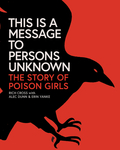
<<•>> edited by Dan Nadel <<•>> The long awaited follow up volume to Nadel's pioneering 2006 anthology of rarely seen and under appreciated comics, Art Out of Time, has at last arrived! This time around we have a tighter focus. While much of the work contained in Art of Time originally appeared in newspapers and broadsheets, all the work contained in this volume originally appeared in comic book form between 1942 and 1980. Extending and expanding his mission to bring art world curatorial standards to comics, Nadel has provided an informative introduction to the book as a whole, along with separate one-page explanations of the underlying reasoning behind each of the thematically groupings into which the work is divided: "Demand and Supply," "Where They Were Drawing From," "It's All In the Routine," and "Expansive Palettes." The artists included here range from the golden age superhero work of H.G. Peter and Mort Meskin, through the post-WW II "atomic age" genre work of Bill Everett, Matt Fox, Jesse Marsh and Pete Morisi, and also including early work focused on hardboiled detective, Sam Hill, by the one and only Harry Lucey, who is best know for his 1960s work on Archie Comics. Another artist whose work included here ranges far from their iconic work is John Stanley, who is best known for his multi-decade run Little Lulu. Nadel has dug up a couple of obscure horror tales from 1962 that should be quite a surprise to most Stanley collectors. Also from the 1960s we have Sam Glanzman's Kona and Pat Boyette's career high, the 25 page, "Children of Doom" from 1967. Heading into the underground era we have fairly obscure yet nonetheless era-defining work from Willy Mendes and John Thompson. And, finally, on the cusp of the undergrounds and the alternative revolution that supplanted them is Sharon Rudahl's 34 page epic, The Adventures of Crystal Night, is presented here in its entirety. Essential, we say.

They bought our dreams... and turned them into comics. Sixty years ago, Jack Kirby, Joe Simon and their cohorts at Prize Comics, asked readers to send them their dreams. Readers did and they were turned into comics. The Strange World of Your Dreams only lasted four issues, but that was enough to fill this book. Sporting a soft, spongy cover, it embodies a bit of visual punning in that it could be considered a surrealistic pillow, of sorts. Comics have been linked to dreams from their very beginnings, but the comics collected here might be the most explicit connection made between the trade-off between individual/personal dreaming and mass/popular entertainment ever made. "WE WILL BUY YOUR DREAMS!" Indeed.

<<•>> selected and edited by Mark Evanier <<•>>
Any Kirby fan opening this book for the first time and realizing what they're holding in their hands will have the same reaction we did: "WOW!" When we first heard about this book/project a year or so ago, we assumed it would be a coffee table type book more or less along the lines of Evanier's previous book titled simply Kirby, which was a swell tome offering an overview of the king's life and work along with a generous election of high quality scans of his original art and published work. The Art of the Simon and Kirby Studio is a different beast altogether. Here we have assembled one of the largest selections of high quality scans of original art ever put between two covers. Thiis massive, oversize, hardcover tome opens with a fifteen page introduction by Evanier, which is then immediately followed by a mind-boggling 350 high-resolution scans of original art that emanated from the Simon and Kirby Studio from 1942 through 1959, with the vast majority of it from the '50s. While other artists' work is on display here, most notably that of S&K Studio members, Mort Meskin and Bill Draut, most is by Jack Kirby. Many complete stories are included along with covers, double-page splashes, unfinished pencils and unpublished pages. Nearly 70 pages from Kirby's seminal Boys' Ranch are here, which is some of the strongest work of his career (although six of the pages are, sadly, incorrectly formatted, resulting in blurred/pixilated images). Also, some amazing pages of Al Williamson inking Kirby that will knock the socks off even the most jaded seen-it-all. Once again, we say, "WOW!"










